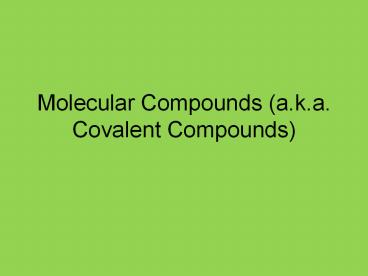Molecular Compounds (a.k.a. Covalent Compounds) - PowerPoint PPT Presentation
1 / 24
Title:
Molecular Compounds (a.k.a. Covalent Compounds)
Description:
Molecular Compounds (a.k.a. Covalent Compounds) Ionic Compounds Review Ionic compounds are the combination of ions. E.g. Na+ + Cl- NaCl. This formula represents the ... – PowerPoint PPT presentation
Number of Views:169
Avg rating:3.0/5.0
Title: Molecular Compounds (a.k.a. Covalent Compounds)
1
Molecular Compounds (a.k.a. Covalent Compounds)
2
Ionic Compounds Review
- Ionic compounds are the combination of ions. E.g.
Na Cl- ? NaCl. - This formula represents the __________ of sodium
ions and chloride ions not the exact number of
them. - They are composed of a ___________________ and
form a crystal structure (e.g. NaCl and CaCl2
which are both salts)
3
Molecular Compounds
- Consist of atoms covalently bonded together
- The elements involved are all __________
4
Some examples
- N2O ? _____________ Gas used at the dentist to
relax patients - NO2 ? _____________ poisonous toxin emitted
from car exhaust
5
More Examples
- H2O ? ______
- CO2 ? ____________ Gas
- exhaled and created during
- combustion reactions
- CO ? ____________________ Lethal gas created
during incomplete combustion
6
Recall
- In ionic compounds, the non-metal rips away the
electron(s) from the metal because the metals
loosely hold their electrons - This creates a positive and negative ion which
attract each other making them stick together
(opposites attract)
7
- Molecular Compounds
- made up of a non-metal
- and a non-metal.
- also called _____________
8
- Molecular Compounds
- ________ electrons (e-) to form a
________________. - Neg. e- are attracted to the Pos. nuclei of both
atoms
9
Molecular Compounds
- Molecular compounds are formed when non metals
share electrons to fill their outer electron
orbit (shell). - If we draw the Lewis Structure for Fluorine,
- We can see that it needs ________
- It wants to share one electron with another atom.
- If it bonds with another fluorine atom
- We draw the shared pair of electrons between the
two atoms.
10
Molecular Compounds
- Many molecular compounds are predictable.
- How will Oxygen bond with Hydrogen to form a
molecule. - Draw the Lewis Structure of both Atoms.
- ________________________
- Clearly we need another Hydrogen atom
- Putting the shared electrons between the atoms.
- The molecule is H2O
The Oxygen atom has 8 valence electrons (full)
and the Hydrogen has 2 valence electrons (full)
11
(No Transcript)
12
Molecular Compounds
- Not all molecular compounds are as predictable.
- How will Oxygen bond with Carbon?
- Draw the Lewis Structures of each atom.
- ___________________________
- If we add one more Oxygen, each oxygen can share
two. - However, if Oxygen will share two and donate one
of its other electrons pairs, Oxygen can bond
with just on Carbon atom.
_____________
_____________
13
Types of Bonds
Water Single bond because ______ pair of
electrons are shared
Carbon Monoxide Triple Bond because
_______pairs of electrons are shared
Carbon Dioxide Double bond because _______pairs
of electrons are shared
14
Molecular Compounds Naming
- So Oxygen can form CO or CO2
- We need a more flexible naming system for
covalent compounds to reflect the many different
bonding possibilities. - To name a covalent compound,
- Starting with the atom that is to the left in the
periodic table, (or lower) - Write the name of the atoms with the prefix
indicating the number of that atom in the
compound. - Change the ending of the last atom to ide.
- The prefixes are,
- _______
- _______
- _______
- _______
- _______
- _______
- _______
- Note, the mono is omitted on the first atom.
- CO _____________
- CO2 _____________
15
Memorize me!
Number Prefix Number Prefix
1 mono 6 _________
2 _________ 7 hepta
3 tri 8 _________
4 _________ 9 nona
5 penta 10 _________
16
Naming Example
- P4O10
- ?Phosphorus - use prefix tetra (4)
- ?Oxygen change ending Oxide
- ?Oxide use prefix deca (10)
- _________
17
Molecular Compounds - Naming
- Name the following compounds
- CF4
- _________
- H2O
- _________
- PF5
- _________
- Write the chemical formula for,
- Sulphur Dioxide
- _________
- DiCarbon Tetrahydride
- _________
18
Molecular Compounds Diatomic Gases
- Molecular compounds show an incredible variety in
structure, physical and chemical properties. - There are categories that further divide covalent
compounds into categories with common properties.
- Diatomic Gases _________
- The Halogens, Oxygen, Nitrogen and Hydrogen form
diatomic gases. - H2 is called Hydrogen Gas not Dihydrogen.
19
- Eg. N2 - _________
- O2 - _________
-
Air
20
Writing Formulas
- ?left-most element goes 1st
- Carbon monoxide
- Carbon (C) ? no prefix therefore C
- - Monoxide Mono 1 therefore, 1 oxygen atom
O - _________
21
Writing Formulas
- Nitrogen dioxide
- Nitrogen (N) ? no prefix therefore N
- - Dioxide Di 2 therefore, 2 oxygen atoms
O2 - _________
22
Writing Formulas
- DiCarbon Tetrahydride
- Dicarbon (C) ? Di 2 therefore C2
- - Tetrahydride (H) ? Tetra 4 therefore, 4
Hydrogen atoms H4 - _________
23
Exceptions that need to be Memorized!
- CH4 _________
- H2O2 _________
- H2O Water
24
These Too!
- NH3 _________
- O3 _________































